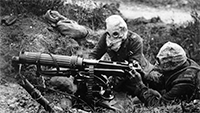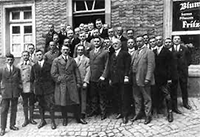When World War I began, in August 1914, Hitler was in Munich, Germany, having lived there for more than a year. A brief stint as a call-up for the army of the Austro-Hungarian Empire in February ended in dismissal on grounds of his being medically unfit. When the war started, however, Hitler volunteered for (and was accepted into) the Bavarian Army. 
He served as a runner, carrying dispatches back and forth along the Western Front, and was on the scene for four major battles: the First Battle of Ypres, the First Battle of the Somme, the Battle of Arras, and the Battle of Passchendaele. Wounded at the Somme, in October 1916, he spent several weeks in a Beelitz hospital and then returned to the fighting in March 1917. A further serious injury came in the form of blindness, the result of a mustard gas attack in the waning days of the war, which ended while he was hospitalized, in Pasewalk. Army officials cited his bravery and awarded him two of the three grades of the military decoration the Iron Cross, 2nd Class and 1st Class. Hitler believed in the rightness of Germany's cause, as a nation-state and as a war participant. He was shocked when Germany agreed to the terms of the Treaty of Versailles and especially shocked at Article 231, which blamed Germany for starting and prolonging the war. Hitler, along with many others at this time, became proponents of the "Stabbled in the Back" narrative, which assigned blame for the defeat of Austria-Hungary and Germany not with the military but with a coalition of civilians, especially people of the Jewish faith and people who believed in the political theory Marxism. 
Returning to Munich and remaining in the army, Hitler found himself appointed to a mission of infiltration of the Deutsche Arbeiterpartie (DAP), the German Workers' Party. The members of this short-lived political party held views of intense nationalism and antisemitism. Members of the DAP, led at that time by Anton Drexler, also espoused a hatred for both capitalism and Marxism. Hitler, in a heated argument with a DAP member, impressed Drexler and others with his oratory skills, and Drexler convinced Hitler to join the party. (He was named party member 555. The party had no membership cards but did assign numbers, consecutively as people joined; the first number was 501, so Hitler was the 55th person to join.) Hitler gave his first public speech on October 16 at a Munich restaurant. He was a hit with the party and with local people at large. He spoke more and more in public and gained larger and larger crowds to hear him speak. He became the DAP's chief of propaganda in early 1920 and, capitalizing on his growing recognition and the party's growing numbers, convinced the party to rename itself the Nationalsozialistiche Deutsche Arbeiterpartie (NSDAP), the National Socialist German Workers' Party. The party name Nazi, an abbreviation, was originally something that others used as a derogatory term; the party members embraced it as their own. Hitler contributed mightily to the early actions of the new party, giving speeches to promote it and its views and designing its banner, a black swastika in a white circle on a red background. When the army discharged Hitler, in March 1920, he transitioned to working full-time for the NSDAP, at its Munich headquarters. He spoke again and again to crowds of growing numbers, spreading the NSDAP messages of nationalism and anti-Marxism. To quell an uprising within the party in 1921, Hitler resigned rather than let the party merge with another entity, the German Socialist Party. The NSDAP central committee agreed to abandon the planned merger and to install Hitler as party chairman, ousting Drexler, the founder. The new chairman had total control of the party. 
Among the ways that Hitler controlled the NSDAP and its message was through the party newspaper, the Völkischer Beobachter (Popular Observer). It began in Munich and later branched out, publishing editions in Berlin and in southern Germany. Filled with anti-Semitic articles, the paper found a wide readership among some circles and also found itself a target of the German government, which suspended publication multiple times. Hitler gained in popularity and notoriety during this time and made the acquaintance of many of like mind and beliefs; among these were Joseph Geobbels, Hermann Göring, Rudolf Hess, Ernst Röhm, and Julius Streicher. Röhm helped organize the Sturmabtelinung (SA), the party's private army. Streicher had his own anti-Semitic newspaper, Der Stürmer (The Stormer), with headquarters in Nuremberg. Next page > Gaining Influence and Control > Page 1, 2, 3, 4, 5, 6 |
|
Social Studies for Kids
copyright 2002–2025
David White




